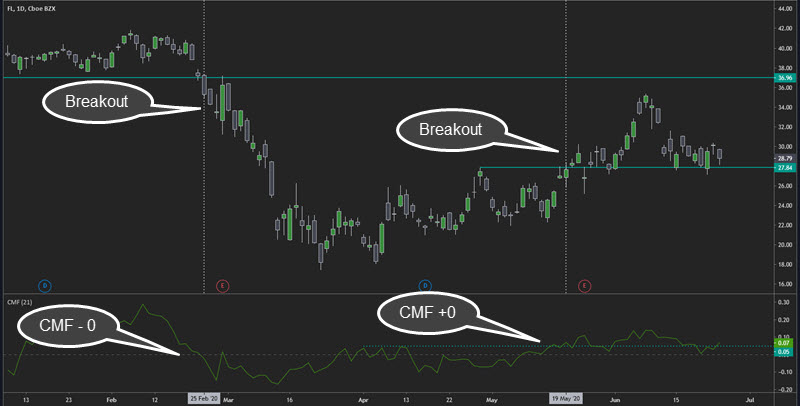- June 25, 2020
- Posted by: Shane Daly
- Category: Trading Article

Marc Chaikin believed that price will follow volume and he designed the Chaikin Money Flow (CMF) based on that premise. It is a volume weighted average of accumulation and distribution of price over a fixed period of time, usually 21 periods.

The Chaikin Money Flow indicator flows across the zero line. The zero line will determine the strength or weakness in the instrument.
The range between the high and low of each period is part of the calculation:
- If price is closing near the highs of the day, accumulation is believed to have taken place
- Closing prices near the low is distribution
- The midpoint of the candlestick or bar is the line in the sand for a weak or strong day
When we have many days in distribution mode, the CMF indicator will head below the zero line. When we continually have price closing near the highs of the periods, the indicator will generally be above the zero line.
Reading the CMF is quite simple:
- Above the zero line would mean the instrument is bullish
- CMF below the zero line points to a weak market
- Different period settings will cause either more movement in the CMF or less depending on how high or low the setting is
When the indicator is whipsawing around the zero line, you are dealing with a market that has a price consensus and may not be worth trading.
Chaikin Money Flow Calculation and Formula
There are two calculations that must take place before the indicator can plot:
- Daily MF = [(Close – Low) – (High – Close)/ (High – Low)] * Volume
- CMF = 21 Day Average of Daily MF / 21 Day Average of Volume
The use of volume makes this trading indicator valuable.
When price rises on increased volume, something we see in breakout and support level bounces, we will see a bigger change in the CMF.
Increased volume on closes near the lows will also give a bigger change in the CMF.
Using Chaikin Money Flow Indicator
The CMF is not a standalone trading tool and traders will want to use another technical analysis technique such as price action trading.
Traders that are interested in more short term style of trading, the 21 day CMF setting should suffice
Longer term traders looking for 3, 6, 9 month period would use 63, 126, 189 respectively.
Confirming Breakout Trades
Every trend begins with a support or resistance breakout. Having price break those levels with increased volume and strong bullish action, having a CMF on the same side of the breakout confirms the breakout.

You can see that the CMF was over the zero line prior to the breakout on the right. This could be considered a foretelling of a successful breakout to come.
CMF As Exit Indicator
If we see the + and – of the zero line as a measure of strength and weakness, consider testing it as a way to exit your trade.

The breakout on the left has the CMF above the zero line and is a legitimate breakout trade. Once the CMF goes under the zero line and we are out of the position.
The second breakout, with the CMF above the zero line, gets upside play and on the far right of the chart, the trade would be exited. Note that price has been ranging for several days before the exit. Holding positions through ranges can be tough on the psyche.
Bottom Line
The Chaikin Money Flow indicator is a confirming indicator which I think is great for breakout traders. Being able to catch a major trend can pay off tenfold.
A rising CMF and price shows a strong instrument and traders would want to be long.
A falling indicator and price shows a weak instrument and short trades would be the preference.
Swing traders would be fine with the 21 period daily setting. Those looking to hold longer term positions can adjust that period.
I say this all the time: test whatever you are deciding to trade. It is far too easy to slap on an indicator like the CMF and start trading live.
Don’t.
